Flag of Italy
 |
|
| Use | National flag and state ensign. |
| Proportion | 2:3 (war flag 1:1) |
| Adopted | 1 January 1948 |
| Design | A vertical tricolour of green, white and red. |
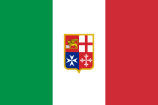 |
|
| Use | Civil ensign. |
| Proportion | 2:3 |
| Adopted | 9 November 1947 |
| Design | A defaced Italian tricolour. |
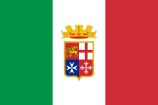 |
|
| Use | Naval ensign. |
| Proportion | 2:3 |
| Adopted | 9 November 1947 |
| Design | A defaced Italian tricolour. |
-
For more details on this topic, see List of Italian flags.
The flag of Italy (Bandiera italiana, often referred to in Italian as Il Tricolore) is a tricolour featuring three equally sized vertical pales of green, white and red, with the green at the hoist side. In its current form it has been in use since 19 June 1946 and was formally adopted on 1 January 1948.[1]
The first entity to use the Italian tricolour was the Repubblica Cispadana (Cispadane Republic) in 1797, after Napoleon's victorious army crossed Italy. During this time many small republics of Jacobin inspiration supplanted the ancient absolute states and almost all, with variants of colour, used flags characterised by three bands of equal size, clearly inspired by the French model of 1790. The colours chosen by the Republic were red and white, the colours of the flag of Milan and green, which was the colour of the uniform of the Milanese civic guard.
Some have attributed particular values to the colours and a common interpretation is that the green represents the country's plains and the hills, white, the snow-capped Alps and red, blood spilt in the Wars of Italian Independence. A more religious interpretation is that the green represents hope, the white represents faith and the red represents charity; this references the three theological virtues.[2]
Contents |
Evolution
Napoleonic era
The first official tricolore italiano, or Italian tricolour was adopted in Reggio Emilia on 7 January 1797, when the XIVth Parliament of the Cispadane Republic, on the proposal of deputy Giuseppe Compagnoni of Lugo, decreed "to make universal the ... standard or flag of three colours, green, white and red ..."[3] This was probably because the Legione Lombarda had carried banners of red, white (from the flag of Milan) and green (from the uniform of the civic guard) and the same colours were later adopted in the banners of the Legione Italiana, which was formed by soldiers coming from Emilia and Romagna.[4] The flag was a horizontal square with red uppermost and, at the heart of the white fess, an emblem composed of a garland of laurel decorated with a trophy of arms and four arrows, representing the four provinces that formed the Republic.
The Cispadane Republic and the Repubblica Transpadana (Transpadane Republic), which had itself been using a vertical Italian tricolour from 1796, merged into the Repubblica Cisalpina (Cisalpine Republic) and adopted the vertical square tricolour without badge in 1798. The flag was maintained until 1802, when the Republic was renamed Repubblica Italiana (Italian Republic) and a new flag was adopted, this time with a red field carrying a green square within a white lozenge.
In 1799, the independent Repubblica di Lucca (Republic of Lucca) came under French influence and adopted as its flag a horizontal tricolour with green uppermost; this lasted until 1801. In 1805 Napoleon installed his sister, Elisa Bonaparte Baciocchi, as Princess of Lucca and Piombino. This affair is commemorated in the opening of Leo Tolstoy's War and Peace.[5]
In the same year, after Napoleon had crowned himself first French Emperor, the Italian Republic was transformed into the Regno d'Italia, or Italico (Kingdom of Italy), under his direct rule. The flag of the Kingdom of Italy was that of the Republic in rectangular form, charged with the golden Napoleonic eagle. This remained in use until the abdication of Napoleon in 1814.
Risorgimento
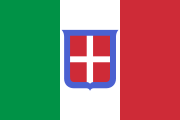
Between 1848 and 1861, a sequence of events led to the independence and unification of Italy (except for Venetia, Rome, Trento and Trieste, or Italia irredenta, which were united with the rest of Italy in 1866, 1870 and 1918 respectively); this period of Italian history is known as the Risorgimento, or resurgence. During this period, the tricolore became the symbol which united all the efforts of the Italian people towards freedom and independence.[6]
The Italian tricolour, defaced with the Savoyan coat of arms, was first adopted as war flag by the Regno di Sardegna-Piemonte (Kingdom of Sardinia-Piedmont) army in 1848. In his Proclamation to the Lombard-Venetian people, Charles Albert said "… in order to show more clearly with exterior signs the commitment to Italian unification, We want that Our troops … have the Savoy shield placed on the Italian tricolour flag."[7] As the arms, gules a cross argent, mixed with the white of the flag, it was fimbriated azure, blue being the dynastic colour.[8]
In the same year, the Granducato di Toscana (Grand Duchy of Tuscany) became constitutional and dropped the Austrian flag, with Austria-Lorraine great coat of arms, in favour of the defaced Italian tricolour with simplified arms. It is worthy of note, however, that the arms bear the red-white-red flag of Austria, the opponent of Italian unification. In 1859, the Grand Duchy officially ceased to exist, being joined to the Duchies of Modena and Parma to form the United Provinces of Central Italy, which used the undefaced tricolour until it was annexed to the Kingdom of Sardinia the following year.
The flag of the Regno costituzionale delle Due Sicilie (Constitutional Kingdom of the Two Sicilies), a white field charged with the coats of arms of Castile, Leon, Aragon, Two Sicilies and Granada, was modified by Ferdinand II through the addition of a red and green fimbriation. This flag lasted from 3 April 1848 until 19 May 1849. The Governo provvisorio della Sicilia (Provisional Government of Sicily), which lasted from 12 January 1848 to 15 May 1849, adopted the Italian tricolour, defaced with the trinacria, or triskelion.
In the same year, the Regno Lombardo-Veneto (Kingdom of Lombardy-Venetia) revolted against the Austrian Empire in the Five Days of Milan, forming the Governo provvisorio della Lombardia (Provisional Government of Lombardy) on 22 March 1848 and Governo provvisorio di Venezia (Provisional Government of Venice), or Repubblica di San Marco, a day later. The flags they adopted marked the link to Italian independence and unification efforts; the former, the Italian tricolour undefaced and the latter, charged with the winged lion of St. Mark, from the flag of the Most Serene Republic, on a white canton.[9] These lasted until 6 and 24 August 1849 respectively.
In 1849, the new Repubblica Romana (Roman Republic) adopted an Italian tricolour, sent from Venice, bearing the legend DIO E POPOLO in red capital letters. This lasted for four months, while the Stati Pontificii della Chiesa (Papal States of the Church) was in abeyance.[10]
Kingdom of Italy (1861–1946)

In 1860, the flag of the Kingdom of the Two Sicilies was again modified to the defaced Italian tricolour with the House of Bourbon-Two Sicilies coat of arms.[11] Adopted on 21 June 1860, this lasted until 17 March 1861, when the Two Sicilies was incorporated into the Regno d'Italia (Kingdom of Italy), after its defeat in the Expedition of the Thousand led by Giuseppe Garibaldi.
On 15 April 1861, the flag of Sardinia was declared the flag of the newly formed Kingdom of Italy.[12] This Italian tricolour, defaced with the armorial bearings of the former Royal House of Savoy was the national flag for 85 years until the birth of the Italian Republic in 1946.
Italian Social Republic (1943–1945)
The civil and state flag of the short-lived Nazi puppet state in northern Italy, the Repubblica Sociale Italiana (Italian Social Republic), or Republic of Salò as it was commonly known, was identical to the flag of the modern Repubblica Italiana (Italian Republic). This was rarely seen, while the war flag, charged with a silver eagle clutching fasci littori (literally bundles of the lictors), was very common in propaganda.[13] Italian fascism derived its name from the fasces, which symbolised imperium, or power and authority, in ancient Rome. Roman legions had carried the aquila, or eagle, as signa militaria.
On 25 April 1945, known as festa della liberazione, the government of Benito Mussolini fell. The Italian Social Republic had existed for slightly more than one and a half years.
Italian Republic
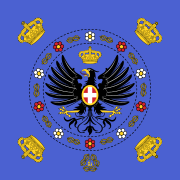
The Italian tricolour was adopted in its current form on 1 January 1948, with the promulgation of the republican constitution and the end of the reign of the House of Savoy over Italy. Article 12 of the Italian Constitution, approved by the Constituent Assembly on the 22 December 1947, states:
| “ | The flag of the Republic is the Italian tricolour: green, white and red, in three vertical bands of equal dimensions.[1] | ” |
The universally adopted ratio is 2:3, while the war flag is squared (1:1).
The Italian naval ensign comprises the national flag defaced with the arms of the Marina Militare; the Marina Mercantile (and private citizens at sea) use the civil ensign, differenced by the absence of the mural crown and the lion holding the gospel, bearing the inscription PAX TIBI MARCE EVANGELISTA MEVS, instead of a sword.[15] The shield is quartered, symbolic of the four repubbliche marinare, or great thalassocracies, of Italy: Venice (represented by the lion passant, top left), Genoa (top right), Amalfi (bottom left), and Pisa (represented by their respective crosses); the rostrata crown was added by Admiral Cavagnari in 1939 to acknowledge the Navy's origins in ancient Rome.[16]
Since 1914, the Italian Air Force have used a roundel of concentric rings in the colours of the tricolor as aircraft marking; substituted, from 1923 to 1943, by encircled fasces. The Frecce Tricolori, officially known as the 313° Gruppo Addestramento Acrobatico, is the aerobatic demonstration team.
Presidential standard
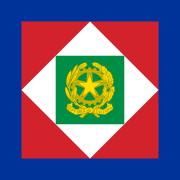
The President of the Italian Republic has an official standard. The current version is based on the square flag of the Napoleonic Italian Republic, on a blue field, charged with the coat of arms of Italy in gold.[17] This emblem was adopted in place of the Royal arms on 5 May 1948.[18]
After the Republic was proclaimed, the national flag was provisionally adopted as distinguishing flag of the head of state, in place of the Royal standard.[19] On the initiative of the Ministry of Defence, a project was prepared in 1965 to adopt a distinct flag.[20] Opportunity suggested the most natural solution was the Italian tricolour defaced with the coat of arms; however, under conditions of poor visibility, this could easily be mistaken for the standard of the President of the United States of Mexico, which is also that country's national flag. The standard is kept in the custody of the Commander of the Reggimento Corazzieri of the Arma dei Carabinieri, along with the war flag (assigned to Regiment in 1878).[21]
The Italian Constitution does not make provision for a Vice-President. However, separate insignia for the President of the Senate, in exercise of duties as acting head of state under Article 86, was created in 1986.[22] This has a white square on the blue field, charged with the arms of the Republic in silver. Distinguishing insignia for former Presidents of the Republic was created in 2001;[23] a tricolour in the style of the Presidential standard, it is emblazoned with the Cypher of Honour of the President of the Republic.[24]
In 1997, on its bicentenary, 7 January was declared festa del tricolore; it is intended as a celebration, though not a public holiday.[26]
Protocol

The law, implementing Article 12 of the Constitution and following of Italy's membership of the European Union, lays down the general provisions governing the use and display of the flag of the Italian Republic and the flag of the European Union (in its territory).[27]
There are no international conventions on flying the flag, but protocol adopted by a large number of countries have such similarities as to suggest lines of commonly accepted practice. In general two areas of exposure are identified: national and international events. In both cases it is generally followed practice that national flags displayed in a group should be of equal size and each hoisted on its own flagstaff, of equal height, or on separate ropes if fixed on yardarm. The flag is flown from sunrise to sunset, except in case of bad weather; exhibition at night is permitted provided it is adequately illuminated. The flag is raised and lowered vividly and with solemnity; it is always treated with dignity and should never be allowed to touch the ground or water.[28] Vertical hoist is transformationally identical to horizontal hoist (i.e. the flag is rotated 90 degrees).
When displayed alongside other flags, the national flag takes the position of honour; it is raised first and lowered last. Other national flags should be arranged in alphabetical order. Where two (or more than three) flags appear together, the national flag should be placed to the right (left of the observer); in a display of three flags in line, the national flag occupies the central position. The European flag is also flown from government buildings on a daily basis. In the presence of a foreign visitor belonging to a member state, this takes precedence over the Italian flag. As a sign of mourning, flags flown externally shall be lowered to half-mast; two black ribbons may be attached to those otherwise displayed.[29]
Pantone matching system
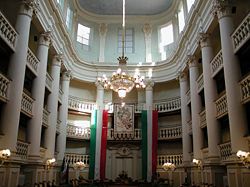
In 2003, after 206 years of service, the authentic colours of the Italian tricolour were specified by the government, but later amended after hot debate on the chosen shades.[30] As of 2006, the official Pantone textile colours defined by law and their rendered RGB, CMYK and hexadecimal values, are:[31]
| Description | Number | RGB | CMYK | HTML | |
|---|---|---|---|---|---|
| Fern Green | 17-6153 TC | 0-141-70 | 100-0-100-45 | #009246 | |
| Bright White | 11-0601 TC | 255-255-255 | 0-0-0-0 | #F1F2F1 | |
| Flame Scarlet | 18-1662 TC | 210-35-44 | 0-100-100-00 | #CE2B37 | |
This approach has been criticised by the Centro Italiano Studi Vessillologici as a "fundamental error."[32]
Resemblances

Given the superficial similarities between the two flags, it may be surmised that the Italian flag formed the basis for the flag of Mexico differenced only in the coat of arms positioned over the white portion. However, the Italian flag actually uses lighter shades of green and red and, more importantly, the two have different aspect ratios; the Italian flag's aspect ratio is 2:3, while the Mexican flag's aspect ratio of 4:7 results in a more elongated rectangular shape.
Given its possible derivation from the French tricolour, the Italian tricolour is similar to many flags of putatively similar origins. The Italian flag is particularly similar to the flag of Ireland, which is green, white and orange (a tone very similar to the red used in the flag of Italy), but with different proportions (1:2 against 2:3) and the flag of Côte d'Ivoire, in which the colours, orange, white and green are reversed, although the proportions are the same.[33] Confusion may also exist between the Italian flag and the flag of Hungary, which, with a 1:2 ratio, has the same colours positioned horizontally with red uppermost.
See also
- Flags of regions of Italy
- Flags of Napoleonic Italy
References
- Italy at Flags of the World
- ↑ 1.0 1.1 Costituzione della Repubblica Italiana Art. 12, 22 dicembre 1947, pubblicata nella Gazzetta Ufficiale n. 298 del 27 dicembre 1947 ed. straord. (published in the Official Gazette [of the Italian Republic] No. 298 of the 27 December 1947 extraordinary ed.) "La bandiera della Repubblica è il tricolore italiano: verde, bianco e rosso, a tre bande verticali di eguali dimensioni"
- ↑ Dal discorso di Giosuè Carducci, tenuto il 7 gennaio 1897 a Reggio Emilia per celebrare il 1° centenario della nascita del Tricolore (from the speech by Giosuè Carducci, held on 7 January 1897 in Reggio Emilia to celebrate the 1st centenary of the birth of the Tricolour), Comitato Guglielmo Marconi International (retrieved 5 October 2008)
- ↑ The tri-coloured standard Getting to Know Italy, Ministry of Foreign Affairs (retrieved 5 October 2008)
- ↑ On 11 October 1796 Napoleon wrote to the Directorate, "Les couleurs nationales qu'ils ont adoptées sont le vert, le blanc et le rouge" (the national colours they have adopted are green, white and red), Corr. Nap. II, No. 1085; see Frasca, Francesco Les Italiens dans l'Armée napoléonienne: Des légions aux Armées de la République italienne et du Royaume d'Italie Etudes napoléoniennes, Tome IV (pp. 374-396) Levallois: Centre d'études napoléoniennes, 1988
- ↑ "Well, Prince, so Genoa and Lucca are now just family estates of the Bonapartes," facsimile of the 1922 English translation by Aylmer and Louise Maude, Project Gutenburg (retrieved 5 October 2008)
- ↑ Ghisi, Enrico Il tricolore italiano (1796-1870) Milano: Anonima per l'Arte della Stampa, 1931; see Gay, H. Nelson in The American Historical Review Vol. 37 No. 4 (pp. 750-751), July 1932
- ↑ "Per viemmeglio dimostrare con segni esteriori il sentimento dell'unione italiana vogliamo che le Nostre truppe ... portino lo scudo di Savoia sovrapposto alla bandiera tricolore italiana." See Lawrence, D.H. (ed. Philip Crumpton) Movements in European History (p. 230) Cambridge University Press, 1989 for an overview
- ↑ Lo Statuto Albertino Art. 77, dato in Torino addì quattro del mese di marzo l'anno del Signore mille ottocento quarantotto, e del Regno Nostro il decimo ottavo (dated in Turin on the fourth of the month of March in the year of our Lord one thousand eight hundred and forty-eight, and of Our Reign the eighteenth)
- ↑ Lawrence, op. cit. (p. 229)
- ↑ Rostenberg, Leona Margaret Fuller's Roman Diary The Journal of Modern History Vol. 12 No. 2 (pp. 209-220), June 1940
- ↑ Scirocco, Alfonso (trans. Allan Cameron) Garibaldi: Citizen of the World (p. 279) Princeton University Press, 2007
- ↑ REGIO DECRETO 24 settembre 1923, n. 2072, convertito nella LEGGE 24 dicembre 1923, n. 2264
- ↑ Foggia della bandiera nazionale e della bandiera di combattimento delle Forze Armate DECRETO LEGISLATIVO del Duce della Repubblica Sociale Italiana e Capo del Governo 28 gennaio 1944 XXII EF, n. 141 (GU 107 del 6 maggio 1944 XXII EF)
- ↑ REGIO DECRETO 28 novembre 1880. The Gagliardetto dei Reali Principi was the same design with a swallowtail instead of a crown in each corner
- ↑ DECRETO LEGISLATIVO del capo provvisorio dello stato 9 novembre 1947, n. 1305 (GU 275 del 29 novembre 1947)
- ↑ La Bandiera della Marina Militare Le nostre tradizioni, Ministero della Difesa (retrieved 5 October 2008)
- ↑ Stendardo del Presidente della Repubblica DECRETO DEL PRESIDENTE DELLA REPUBBLICA 9 ottobre 2000 (GU 241 del 14 ottobre 2000)
- ↑ Foggia ed uso dell'emblema dello Stato DECRETO LEGISLATIVO 5 maggio 1948, n. 535 (GU 122 del 28 maggio 1948 suppl. ord.)
- ↑ Foglio d'Ordine 11 febbraio 1948
- ↑ Foglio d'Ordine 22 settembre 1965, n. 76; DECRETO DEL PRESIDENTE DELLA REPUBBLICA 22 marzo 1990 e 29 giugno 1992
- ↑ Lo Stendardo Presidenziale I Corazzieri, Arma dei Carabinieri (retrieved 5 October 2008)
- ↑ "Le funzioni del Presidente della Repubblica, in ogni caso che egli non possa adempierle, sono esercitate dal Presidente del Senato" (the functions of the President of the Republic, in all cases in which he cannot carry them out, shall be exercised by the President of the Senate)
- ↑ Insegna distintiva degli ex Presidenti della Repubblica DECRETO DEL PRESIDENTE DELLA REPUBBLICA 17 maggio 2001 (GU 117 del 22 maggio 2001)
- ↑ DECRETO DEL PRESIDENTE DELLA REPUBBLICA 14 ottobre 1986, n. 19/N
- ↑ REGIO DECRETO 22 aprile 1879
- ↑ Celebrazione nazionale del bicentenario della prima bandiera nazionale LEGGE 31 dicembre 1996, n. 671 (GU 1 del 2 gennaio 1997)
- ↑ Disposizioni generali sull'uso della bandiera della Repubblica italiana e di quella dell'Unione europea LEGGE 5 febbraio 1998, n. 22 (GU 37 del 14 febbraio 1998) e Regolamento recante disciplina dell'uso delle bandiere della Repubblica italiana e dell'Unione europea da parte delle amministrazioni dello Stato e degli enti pubblicie DECRETO DEL PRESIDENTE DEL CONSIGLIO DEI MINISTRI 7 aprile 2000, n. 121 (GU 112 del 16 maggio 2000)
- ↑ Znamierowski, Alfred The World Encyclopedia of Flags London: Lorenz Books, 1999
- ↑ The Rules of Protocol regarding national holidays and the use of the Italian flag Presidency of the Council of Ministers, Department of Protocol (retrieved 5 October 2008)
- ↑ Italian opposition in flap over flag BBC News, 28 April 2003 14:40 BST
- ↑ Disposizioni generali in materia di cerimoniale e di precedenza tra le cariche pubbliche DECRETO DEL PRESIDENTE DEL CONSIGLIO DEI MINISTRI 14 aprile 2006 (GU 174 del 28 luglio 2006)
- ↑ Martinelli, Alessandro La percezione intellettualé del colore SocialDesignZine, 19 gennaio 2004
- ↑ The World Factbook Central Intelligence Agency (United States of America), 2008
External links
- (Italian) La Bandiera degli italiani Presidenza della Repubblica, Palazzo del Quirinale
- (Italian) Centro Italiano Studi Vessillologici (Italian Centre for the Study of Vexillology)
|
|||||||||||
|
||||||||